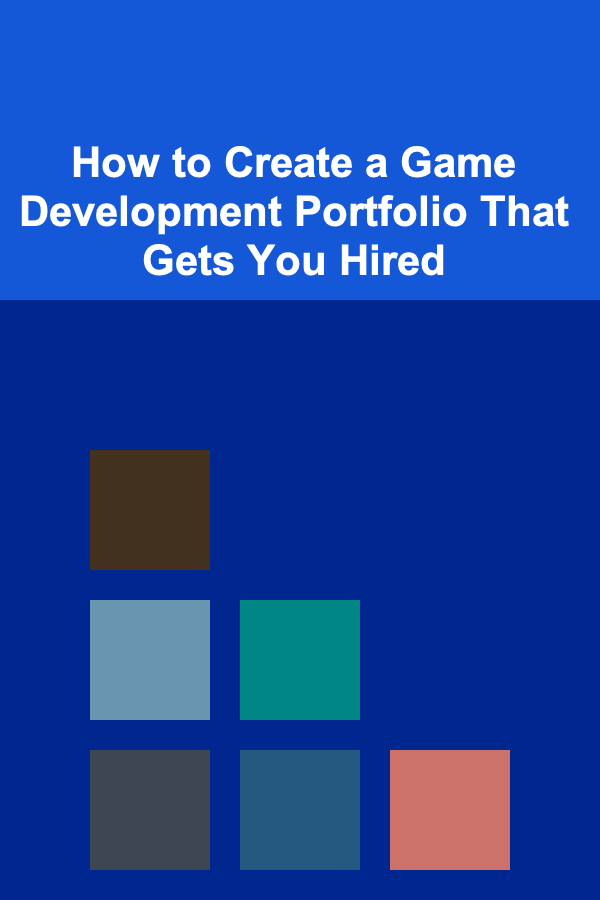
How to Create a Game Development Portfolio That Gets You Hired
ebook include PDF & Audio bundle (Micro Guide)
$12.99$10.99
Limited Time Offer! Order within the next:

A strong portfolio is one of the most critical tools for game developers, whether you're a budding programmer, designer, or artist. It showcases your skills, creativity, and ability to work on real-world projects. In a competitive industry like game development, a portfolio isn't just a nice-to-have---it's a must-have. But creating a portfolio that stands out and gets you hired takes more than just throwing together a few projects. This article will explore how to build a compelling game development portfolio that can help you land that dream job.
Understand What Employers Are Looking For
Before diving into the details of building your portfolio, it's crucial to understand what employers are seeking when they look at your work. Hiring managers in the game development industry want to see the following:
- Technical Skills: Your ability to solve problems and write clean, efficient code is a primary concern. They will also want to see your proficiency with game engines like Unity or Unreal Engine, as well as your familiarity with programming languages (C#, C++, Python, etc.).
- Creativity and Innovation: Game development is about more than just executing tasks. Employers want to see that you can think outside the box and bring new ideas to the table. Showcase unique mechanics, innovative gameplay features, or visually striking art in your projects.
- Team Collaboration: Even if you're applying for a solo developer role, game development is usually a team effort. Employers will look for evidence that you can work well with others, whether that's through collaborating on projects or contributing to open-source communities.
- Problem-Solving: Game development is full of challenges, and the ability to solve complex issues will impress employers. Demonstrating how you've overcome obstacles in your projects is a great way to show this skill.
- Passion and Dedication: Hiring managers want to see that you're genuinely passionate about game development. This can be conveyed through the complexity and quality of your projects, but also through your involvement in the broader community (e.g., contributing to forums, attending game jams, etc.).
Choose the Right Projects to Showcase
Your portfolio should be a reflection of your abilities and interests. While the number of projects matters less than the quality, it's important to have a diverse selection to demonstrate the full range of your skills. Here are the types of projects you should consider including:
A. Personal Projects
These are the projects that will best reflect your creativity and commitment. Whether it's a full-fledged game or a simple prototype, personal projects allow you to work on what excites you. Employers love seeing passion projects because they show your initiative and your ability to carry an idea from concept to completion.
- Example: A unique puzzle game with original mechanics.
- Tip: Make sure to highlight the specific role you played in the project. If you were the lead programmer, artist, or designer, clearly state that.
B. Game Jam Entries
Participating in game jams is a great way to showcase your ability to work under pressure and collaborate with others. These time-limited projects can highlight your problem-solving skills, creativity, and ability to meet deadlines.
- Example: A game made in 48 hours around a specific theme, such as "space exploration" or "dark humor."
- Tip: Even if your game jam entry isn't perfect, include it in your portfolio and discuss what you learned from the experience. Employers appreciate seeing how you handle constraints.
C. Collaborative Projects
Game development often involves working in teams, and employers want to see that you can collaborate effectively. Including collaborative projects---whether they were class projects, freelance jobs, or open-source contributions---can show your ability to work within a team and handle different roles.
- Example: A multiplayer online game where you collaborated with other developers for coding, art, and sound.
- Tip: Be transparent about your role in the project, and make sure to credit team members appropriately.
D. Commercial or Freelance Work
If you've worked on commercial projects, whether as a freelancer or in a paid position, these should definitely be included in your portfolio. They demonstrate your professionalism and your ability to meet client expectations and deadlines.
- Example: A mobile game developed for a small studio or a freelance project where you contributed to the design or code.
- Tip: Include any measurable success, such as downloads or sales figures, if available.
E. Prototypes and Concepts
If you're just starting out and don't have a lot of completed projects, showing well-developed prototypes or game concepts can still make a strong impression. It's important to demonstrate that you understand the core principles of game design, even if the game is unfinished.
- Example: A prototype for a side-scrolling platformer with basic mechanics in place.
- Tip: Highlight the unique features or mechanics of your prototype. Show that you can think about how the game will be played and how it will evolve.
Building Your Portfolio Website
A well-organized, professional portfolio website is essential for making a positive impression. Your website should be easy to navigate, visually appealing, and optimized for mobile devices. Here are the key components your portfolio website should include:
A. Introduction and About Me Section
This section should give a brief overview of who you are, what you specialize in, and what excites you about game development. It's a great place to express your passion and personality.
- Tip: Keep it concise and focused on what you bring to the table as a game developer.
B. Project Showcase
Each project you include should have its own page or section with the following:
- Project Description: A short summary of the game, its mechanics, and any unique features.
- Your Role: Clearly describe your contributions to the project (e.g., programming, art, design, etc.).
- Technologies Used: List the tools and technologies you used, such as game engines, programming languages, and software.
- Play the Game: Include a playable version or a downloadable link (if applicable). If not, include a video walkthrough or demo.
- Tip: Make sure your projects are easy to access. If you have a web-based game, embed it directly on your website. If it's a downloadable game, provide clear instructions on how to play.
C. Resume and Contact Information
Make sure to include an updated resume with relevant work experience, education, and any certifications you have in game development. Your contact information should be easy to find, with an option for potential employers to reach out via email or social media.
- Tip: Make your resume downloadable as a PDF so that employers can easily keep a copy for their records.
D. Professionalism and Design
Your portfolio website is your first impression, so make sure it reflects your skills and attention to detail. A clean, professional design will help convey that you understand good user experience and can present information clearly.
- Tip: Avoid clutter. Use simple navigation and high-quality images and videos to showcase your work.
Additional Tips for a Strong Portfolio
A. Document Your Process
Employers love seeing how you approach game development. Including a section or blog that documents your design, development, and problem-solving processes can give insight into how you think and work.
- Tip: Write post-mortems or dev blogs for each project to showcase your problem-solving skills and lessons learned.
B. Add Social Proof
Including testimonials from colleagues, instructors, or clients can lend credibility to your portfolio. Social proof can give employers confidence in your ability to work in a team and deliver quality work.
- Tip: Ask for recommendations or endorsements from people you've worked with on game development projects.
C. Keep It Updated
Your portfolio is a living document. Make sure to add new projects, skills, and achievements as you progress in your career. Regularly updating your portfolio will keep it relevant and show potential employers that you're continuously improving.
- Tip: Set a reminder to update your portfolio every few months, adding new work and refining your descriptions.
What to Avoid in Your Portfolio
To ensure your portfolio doesn't hinder your chances of getting hired, here are a few things you should avoid:
- Incomplete or Buggy Games: If a project isn't finished or has major bugs, it's better not to showcase it or be transparent about its incomplete status.
- Too Many Projects: It's better to have a few high-quality projects than to overwhelm potential employers with a long list of mediocre work.
- Neglecting Code Quality: If you're a programmer, make sure your code is clean, well-commented, and organized. Employers will likely check your code if they're considering you for a technical role.
- Overly Complex or Messy Website: Your portfolio website should be easy to navigate and visually appealing, but it doesn't need to be overly complex. Keep it simple and user-friendly.
Conclusion
Building a game development portfolio that gets you hired requires careful thought and planning. By selecting the right projects, showcasing your technical and creative abilities, and presenting your work in a polished and professional manner, you can make a strong impression on potential employers. Remember, your portfolio isn't just about the games you've made; it's about showing that you have the skills, passion, and problem-solving abilities to succeed in the competitive world of game development. Keep refining your portfolio, stay current with industry trends, and continue improving your skills---this will set you on the path to landing your dream job.
Reading More From Our Other Websites
- [Home Family Activity 101] How to Host a Family Movie Marathon That Everyone Will Love
- [Home Maintenance 101] How to Care for Your Home's Copper Pipes to Prevent Corrosion
- [Star Gazing Tip 101] Moonlit Nights and Meteor Showers: Romantic Getaways for Star Lovers
- [Home Budget Decorating 101] How to Decorate with Textiles (Throws, Pillows, Rugs) Affordably
- [Home Pet Care 101] How to Maintain Pet Skin Care: Tips for Healthy Skin
- [Home Storage Solution 101] How to Utilize a Sofa with Built-In Storage for Your Living Room
- [Personal Care Tips 101] How to Apply Sunscreen on Your Scalp to Prevent Sunburn
- [Home Rental Property 101] Best Ways to Rent Out Your Home: Tips for Success
- [Organization Tip 101] How to Set Up a Family Command Center in Your Entryway
- [Personal Care Tips 101] How to Use Shaving Cream for a Pain-Free Underarm Shave

How to Boost Your Brain Health Through Prevention
Read More
How to Create a Cozy and Inviting Atmosphere Through Home Staging
Read More
How to Use Seasonal Storage Solutions for Holiday Items
Read More
Smart Ways to Save on Gym Memberships and Stay Fit on a Budget
Read More
10 Tips for Photographing Your Toy Collection for Online Sales
Read More
10 Tips for Paying Off Debt Faster Using Windfalls
Read MoreOther Products

How to Boost Your Brain Health Through Prevention
Read More
How to Create a Cozy and Inviting Atmosphere Through Home Staging
Read More
How to Use Seasonal Storage Solutions for Holiday Items
Read More
Smart Ways to Save on Gym Memberships and Stay Fit on a Budget
Read More
10 Tips for Photographing Your Toy Collection for Online Sales
Read More